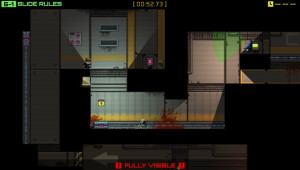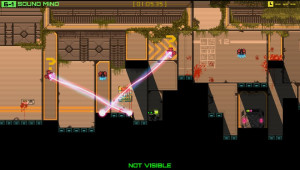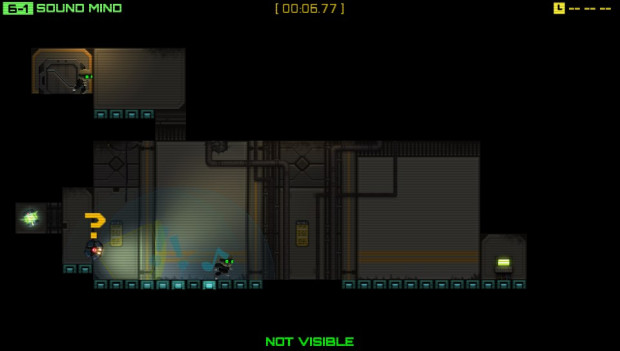Stealth Inc: A Clone in the Dark Review
Recently, for any console gamers seeking a challenge, it seems that online stores are the only way to go. Away from the constraints of a traditional physical release, developers who ply their trade on XBLA or PSN are usually able to ramp up the difficulty, creating a firm but fair experience within their games that will often punish the slightest mistake. One such example of this is Stealth Inc: A Clone in the Dark, which comes to us from developer Curve Studios, and has been released for both PS3 and PlayStation Vita. Players are tasked with guiding a nameless clone through a number of testing chambers, dodging obstacles and avoiding detection along the way, with the ultimate goal of reaching the exit door.
The gameplay in Stealth Inc is viewed from a 2D perspective, with both stealth and platforming being the main components of the gameplay. While the finish time that you will be awarded for each test chamber will seem fairly short, at around two to four minutes per level, the fact is that each level will take most players a little longer. This is because each time your clone dies (and this will happen fairly frequently), the clock is reset back to your most recent checkpoint. Though this may sound like an unfair disadvantage for those who are less skilled at the game—particularly as online leaderboards play a big part in encouraging players to return for another go—most of the time spent in each level actually comes from attempting to decipher the fiendishly tricky navigational puzzles that need to be overcome in order to progress. There is no doubt that these puzzles are unashamedly difficult and mainly revolve around trial and error gameplay. Although players must figure out what each button or switch does before working out how to use them effectively in unison, none of the puzzles really ever feel unfair, or as if they’re relying on skills or experiences that the game hasn’t yet taught you.
 Stealth Inc is broken down into eight different chapters, with each chapter consisting of eight compulsory levels and two bonus levels (unlocked by meeting time goals or picking up bonus objects in every level of the chapter). The early levels in each chapter gradually introduce the player to whichever new gameplay element comes into effect in the chapter — be it teleporting, turrets or sensors — before later levels begin to mix in elements from earlier chapters, which creates an extra challenge in itself. Each chapter is finished with a boss level, which again heavily features the particular mechanic of the chapter you’re playing through, and these levels ramp up the difficulty again to ensure that you’ve been paying close attention.
Stealth Inc is broken down into eight different chapters, with each chapter consisting of eight compulsory levels and two bonus levels (unlocked by meeting time goals or picking up bonus objects in every level of the chapter). The early levels in each chapter gradually introduce the player to whichever new gameplay element comes into effect in the chapter — be it teleporting, turrets or sensors — before later levels begin to mix in elements from earlier chapters, which creates an extra challenge in itself. Each chapter is finished with a boss level, which again heavily features the particular mechanic of the chapter you’re playing through, and these levels ramp up the difficulty again to ensure that you’ve been paying close attention.
In terms of presentation, Stealth Inc is, despite its punishing difficulty level, quite charming, if in an incredibly sarcastic manner. Objectives and tips are given to you through messages projected onto walls, à la Splinter Cell: Conviction, although these messages can also convert into sardonic jabs at the player’s gaming abilities, particularly in the event of deaths or failures, with projections such as ‘Got There Eventually’ or ‘Duck Cretin’ provoking a wry smile on your face, but also making you cry a little inside at your obvious lack of skill. The one downside to Stealth Inc’s visuals is that the character modelling of your clone appears very low-res, particularly when viewed against the static, almost hand-drawn backgrounds of the testing chambers. In terms of music, the experience is overall a little synth-heavy and feels very 1980s sci-fi in the mood that it tries to evoke, but overall it is quite good and never feels too repetitive or encroaching on the gameplay.
 With the title of the game being Stealth Inc, it should come as no surprise that a lot of your time with the game will be spent in shadows, waiting for the perfect opportunity to make your way into the light and do what must be done, whether it’s hacking a computer or dodging the sensor-arc of a hostile robot. Some of the cleverest puzzles in the game rely on this balance of light and dark, with your clone having to match the speed of a rotating fan’s blades to stay in its shadow, or using a robot to match up with a series of sensor beams by raising and lowering the platforms that it is traversing. While there is a certain level of forgiveness in some of the levels if you step into the light, other test chambers – and particularly the boss levels – punish you almost instantaneously if you venture out of the safety of darkness, with death and a sad journey back to your most recent checkpoint being your result. Once you make it safely to the end of a level, the game gives you a grade depending on how many times you died, how long it took you to complete the level, and how many times you were spotted by cameras, robots and the like. The ultimate rating is nine stars, or an S-rank, which affords you bragging rights on the leaderboards and is a huge incentive to go back and play through the levels again, particularly once you’ve understood the mechanics of a particular chamber, and know which switch does what.
With the title of the game being Stealth Inc, it should come as no surprise that a lot of your time with the game will be spent in shadows, waiting for the perfect opportunity to make your way into the light and do what must be done, whether it’s hacking a computer or dodging the sensor-arc of a hostile robot. Some of the cleverest puzzles in the game rely on this balance of light and dark, with your clone having to match the speed of a rotating fan’s blades to stay in its shadow, or using a robot to match up with a series of sensor beams by raising and lowering the platforms that it is traversing. While there is a certain level of forgiveness in some of the levels if you step into the light, other test chambers – and particularly the boss levels – punish you almost instantaneously if you venture out of the safety of darkness, with death and a sad journey back to your most recent checkpoint being your result. Once you make it safely to the end of a level, the game gives you a grade depending on how many times you died, how long it took you to complete the level, and how many times you were spotted by cameras, robots and the like. The ultimate rating is nine stars, or an S-rank, which affords you bragging rights on the leaderboards and is a huge incentive to go back and play through the levels again, particularly once you’ve understood the mechanics of a particular chamber, and know which switch does what.
Whilst Stealth Inc: A Clone in the Dark is a game that will often have you swearing in frustration, mainly at your own stupidity, the sense of accomplishment that it creates within you once you complete a level is unlike anything found in many other games that attempt to take you by the hand and guide you lovingly towards the next level. While the puzzles are often overwhelming at first glance, patience, experimentation and a dash of platforming skills will see you successfully through most of them, even if you will see your clone horrifically mangled more than once before you come to the end. With a strong encouragement for replayability, and a level of challenge that inspires a call for ‘just one more go’, Stealth Inc: A Clone in the Dark is a game that deserves to be brought out of the shadows.
About This Post
